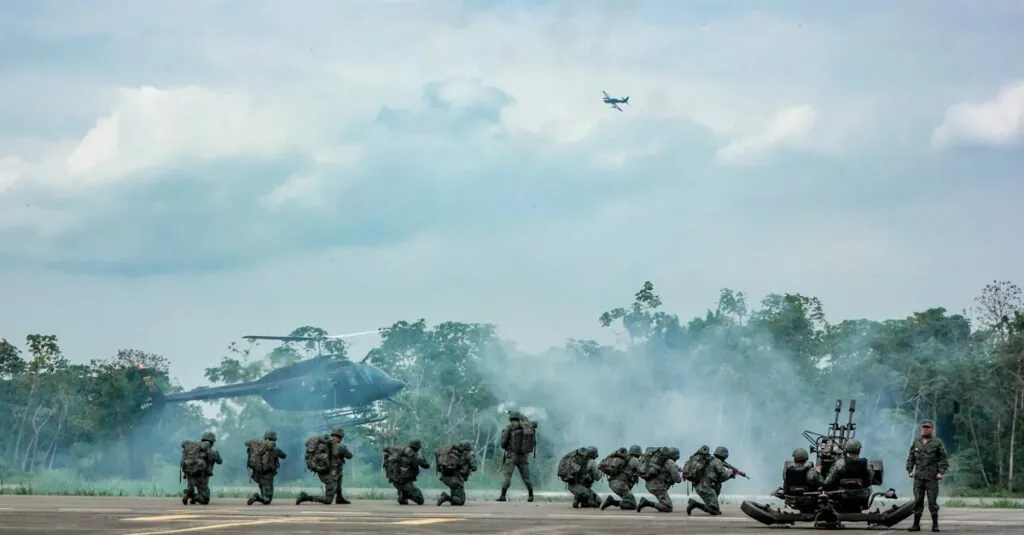Table of Contents
ToggleWhen it comes to fitness, most people think of treadmills, yoga mats, and maybe a few too many kale smoothies. But what if getting fit meant more than just sweating it out in a gym? Enter military fitness training, where push-ups and burpees are just the warm-up for a whole new level of strength and endurance.
Overview of Military Fitness Training
Military fitness training emphasizes functional strength, endurance, and agility. It combines various elements such as strength training, conditioning, and tactical drills. This type of training prepares individuals not just for combat situations but also for everyday physical challenges.
Typical workouts include high-intensity interval training and obstacle courses. These demanding routines enhance cardiovascular health and build muscle simultaneously. Workouts often incorporate bodyweight exercises like push-ups, pull-ups, and squats, which promote strength without relying on traditional gym equipment.
Nutrition plays a critical role in military fitness. Proper diets focus on balanced macronutrients to fuel rigorous training and recovery. Hydration is essential as it ensures optimal performance, especially during intense physical activities.
Teamwork also forms a significant aspect of military training. Cohesive group workouts foster camaraderie and develop communication skills under stress. Individual accountability ensures that all participants contribute to group goals, enhancing overall fitness.
Assessment involves rigorous evaluations, including timed runs and strength benchmarks. These metrics track progress over time, ensuring that objectives align with rigorous military standards. Routines adapt based on individual capabilities, focusing on continuous improvement.
Participating in military fitness training cultivates discipline and resilience. Participants often discover newfound levels of endurance and strength. Training sets a foundation not merely for military readiness but also for enhancing overall physical fitness, translating into improved daily life performance.
Benefits of Military Fitness Training
Military fitness training offers numerous benefits that extend beyond physical conditioning. Participants experience significant improvements in strength, endurance, and mental fortitude.
Physical Strength and Endurance
Physical strength and endurance play vital roles in military fitness training. Participants engage in high-intensity workouts that focus on bodyweight exercises and functional movements. These activities enhance muscle tone and build endurance over time. Strength training targets major muscle groups, improving overall fitness levels while preparing individuals for real-world physical challenges. Cardiovascular health benefits from rigorous conditioning drills, increasing stamina and reducing fatigue. Participants often report higher energy levels and better performance during both training and daily activities. The transformative potential of military training encourages individuals to push their limits and achieve new physical milestones.
Mental Resilience
Mental resilience is a critical component of military fitness training, shaping individuals’ ability to cope with challenges. Exposure to demanding situations fosters mental toughness and enhances focus under pressure. Participants often engage in teamwork-oriented drills that promote communication and collaboration. Overcoming obstacles together builds camaraderie, reinforcing a sense of belonging. Self-discipline grows through consistent training routines, encouraging participants to push through discomfort. Understanding the value of persistence helps individuals face everyday challenges more effectively. Ultimately, participants emerge with improved confidence and a strong mindset, ready to tackle various life situations.
Key Components of Military Fitness Training
Military fitness training incorporates various essential components designed to enhance overall performance. Each component plays a vital role in developing strength, endurance, and agility.
Cardiovascular Training
Cardiovascular training forms the foundation of military fitness. This type of training includes high-intensity interval training and sustained endurance exercises. Individuals engage in activities like running, cycling, or rowing to improve heart health and stamina. Beyond improved endurance, cardiovascular activities enhance recovery times during rigorous routines. Participants often experience increased energy levels in everyday tasks due to this training.
Strength Training
Strength training is crucial for building functional strength necessary in combat and daily activities. Bodyweight exercises such as push-ups, squats, and pull-ups dominate military workouts. Participants utilize heavy weights during resistance training to promote muscle growth and overall power. Structured programs incorporate various lifting techniques to develop core and upper body strength. Enhanced strength directly translates to better performance under physical and psychological stress.
Flexibility and Mobility
Flexibility and mobility training significantly contribute to injury prevention and performance enhancement. Mobility drills include dynamic stretches that prepare the body for intense activities. Individuals practice yoga and specific stretching routines to improve range of motion and reduce muscle tension. Increased flexibility allows participants to execute movements with greater efficiency, particularly during obstacle courses or tactical drills. Regular inclusion of flexibility work ensures participants maintain balance and coordination, crucial in rigorous scenarios.
Common Military Fitness Training Programs
Common military fitness training programs encompass various methods designed to enhance physical capabilities. Boot camp training combines cardiovascular elements with strength exercises, focusing on agility and endurance. Circuit training integrates timed intervals of different exercise routines, encouraging maximum effort for short durations.
Obstacle courses challenge participants with hurdles, walls, and climbing elements, building both strength and coordination. Endurance training techniques involve long-distance running and rucking, developing stamina necessary for extended physical exertion. High-intensity interval training, often referred to as HIIT, pushes individuals to alternate between intense bursts of activity and short rest periods, promoting cardiovascular fitness.
Strength-focused training emphasizes bodyweight exercises such as push-ups, pull-ups, and squats. Each of these exercises enhances functional strength, crucial for both combat and everyday tasks. Resistance training, using weights and other equipment, complements bodyweight workouts, further increasing muscle mass and overall strength.
Nutrition programs support these rigorous training schedules, emphasizing balance with macronutrients vital for recovery. Hydration strategies also play a critical role, ensuring participants maintain optimal performance levels during workouts.
Team-based challenges foster camaraderie, enhancing motivation among participants while developing communication skills. Regular assessments, such as timed runs and strength benchmarks, track individual progress, aligning fitness levels with military standards.
Overall, each of these programs contributes significantly to building a well-rounded fitness regimen, equipping individuals to meet demands both in military environments and daily life. A focus on mental resilience becomes evident, as participants learn to push through physical and psychological barriers, reinforcing the holistic approach of military fitness training.
Tips for Effective Military Fitness Training
Incorporate variety into workouts to prevent boredom and promote overall fitness. High-intensity interval training and obstacle courses provide diverse challenges. Aim for a mix of cardiovascular, strength, and flexibility exercises.
Track progress consistently through regular assessments. Timed runs and strength benchmarks offer clear insights into improvements. Set specific, achievable goals to maintain motivation and focus.
Prioritize nutrition alongside training to support performance. Balanced macronutrients aid recovery, while proper hydration enhances endurance. Meal planning ensures that nutritional needs align with rigorous training schedules.
Engage in teamwork during training sessions. Team-based activities foster camaraderie and enhance communication skills. Collaboration boosts motivation and accountability, crucial for achieving fitness goals together.
Schedule consistent training sessions to build a solid routine. Consistency is key to developing strength and improving endurance. Flexibility in timing accommodates life’s demands.
Encourage mental resilience through challenging workouts. Facing obstacles develops a strong mindset and enhances problem-solving abilities. Embrace discomfort as part of growth and improvement.
Utilize bodyweight exercises for functional strength. Movements like push-ups, squats, and burpees mimic real-life activities. Resistance training complements bodyweight routines to build muscle mass.
Incorporate recovery strategies to optimize performance. Active recovery days contribute to injury prevention and lead to better overall fitness. Rest days are essential for muscle growth and mental well-being.
Explore different military fitness programs for inspiration. Boot camps and circuit training emphasize both cardiovascular and strength elements. Keeping workouts fresh encourages continuous improvement and enjoyment.
Military fitness training offers a dynamic and effective approach to physical fitness that transcends traditional methods. By focusing on functional strength endurance and mental resilience participants can achieve significant improvements in their overall health and performance. The emphasis on teamwork and accountability not only enhances physical capabilities but also cultivates essential life skills.
Incorporating high-intensity workouts and varied training methods keeps individuals engaged and motivated. With a strong focus on nutrition and recovery strategies participants can optimize their training outcomes. Embracing the challenges of military fitness training ultimately leads to a more disciplined and resilient mindset equipping individuals to face both physical and mental obstacles in everyday life.




